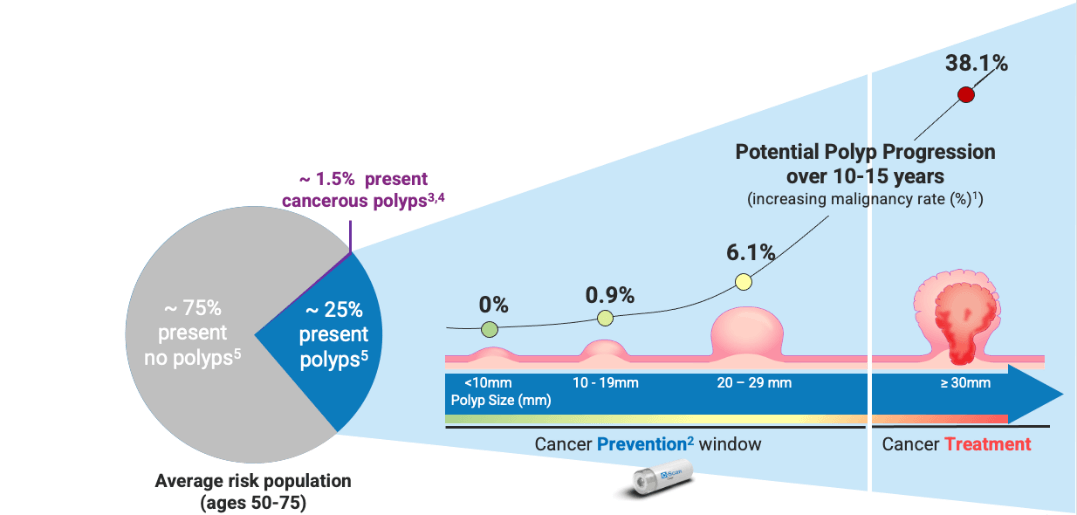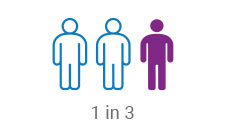Colorectal cancer can be prevented – why wait?
It can take as many as 10 to 15 years before a polyp develops into invasive cancer. We aim to detect the precursors of CRC before it is too late.
1. Pickhardt et al. Glin. Gatro. And Hep. 2010; 8; 610
2. Can Colorectal Polyps and Cancer Be Found Early? American Cancer Society. Accessed August 2021
3. Corley, Douglas A et al. Clinical gastroenterology and hepatology: the official clinical practice journal of the American Gastroenterological Association vol. 11,2 (2013): 172-80. doi:10.1016/j.cgh.2012.09.010
4. Estimate calculated as CRC prevalence versus total average risk population (age 50-74 years) in the U.S.


Alex Ovadia
Colorectal cancer (CRC) is the 3 most commonly diagnosed cancer, with more than 1.9 million new cases identified every year globally. The survival rate of CRC is 64% at 5 years and a bit over 935,000 deaths occur annually worldwide as a result of CRC.
While 1.5% of the average-risk screening population presents cancerous polyps in the colon and rectum at a given time, approximately 25% of the same population presents benign polyps with the potential to turn into cancer over time. It can take as many as 10 to 15 years before a pre-cancerous polyp develops into invasive cancer. As such, there is a crucial detection window for the prevention of colorectal cancer, through the detection of these benign polyps with potential future malignancy.
While routine screening is recommended by The American Cancer Society for healthy people aged 45 years and older, screening adherence remains low, especially with the younger population, which may find current screening methods too disruptive. This is in part due to barriers associated with the colonoscopy procedure – required laxative preparation, invasiveness, possible pain, embarrassment, and risks of cross-contamination – as well as barriers such as stool handling, required for stool-based screening methods.
About 1 in 3 adults among the targeted screening population avoids having a colonoscopy in the U.S., and adherence in other regions of the world such as Europe and Asia are even lower.
There is a serious unmet need for a patient-friendly screening option that can overcome screening barriers while also enabling pre-cancerous polyp detection. Most patient-friendly CRC screening tests currently available or poised to enter the market are primarily designed to detect cancer. As such, they do not necessarily provide patients with the time window to pre-empt the disease.
At Check-Cap, we are committed to addressing this unmet need as we are very sensitive to patient-oriented needs. The C-Scan system was intentionally designed as a prep-free test for colorectal screening to detect polyps before they may turn into cancer.
We believe the C-Scan System has the potential to significantly improve patient outcomes by increasing screening adherence worldwide and helping millions of people stay healthy through preventive CRC screening.
-Alex Ovadia, CEO of Check-Cap
global colorectal cancer
incidence on the rise
CRC estimated new annual cases
million
WORLDWIDE
U.S.
CRC estimated related deaths
WORLDWIDE
U.S.
CRC estimated economic burden associated with CRC treatment
billion
WORLDWIDE
billion
U.S.
High Prevalence of Colorectal Polyps
1 in 4 of the asymptomatic average-risk screening population presents benign polyps in the colon, with the potential to turn into cancer over time

Screening Rates Remain Low
In the U.S., 1 in 3 adults, 50-75, is not getting screened as recommended

Most Commonly Diagnosed Cancers
Worldwide estimated figures, in millions, 2020
- Lung
- Breast
- 60% increase expected by 2030
- Prostate
- Stomach

